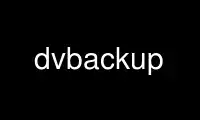
This is the command dvbackup that can be run in the OnWorks free hosting provider using one of our multiple free online workstations such as Ubuntu Online, Fedora Online, Windows online emulator or MAC OS online emulator
PROGRAM:
NAME
dvbackup — Converter from arbitrary data to a DV stream
SYNOPSIS
dvbackup [--version] [-n|--ntsc-mode] [-d|--decode] [-t|--verify] [-b|--set-backup-
title=TITLE] [--set-picture=PPM-FILE] [-v|--verbose] [-p|--prefix=COUNT]
[--test=COUNT] [-r|--recover] [--enable-audio] [-?|--help] [--usage]
DESCRIPTION
This manual page documents briefly the dvbackup tool.
This manual page was written for the Debian distribution because the original program does
not have a manual page.
As you probably know, current digital camcorders can save approximately 13 GB of data on
those tiny DV cartridges at a speed of 3.6 MB/second. That's fast. Very fast. It's faster
than most DAT streamers which only work at 1 MB/sec or less. We can not use all of the
data, but 10 GB should be good enough for everyone.
That's nice, but how can we use this to save data on it? And here comes the fun part: If
you read the DV documentation carefully, you will notice that the AC DCT coefficients of
the video data blocks (8x8 pixels in size) get a fixed amount of space in the DV data
stream, but can be terminated earlier with a certain code sequence. So let's have some
fun: We terminate the AC coefficients immediately leaving only the DC coefficient for a
fancy penguin picture and use the rest for our backup data. Future implementations could
easily add a little picture showing the currently written file or something like that.
Then there is the audio data, which is written uncompressed onto the tape. That means: We
tell the camcorder at the beginning of each frame, that we won't use audio at all but fill
the space reserved for it with data. Easy, but somewhat hacky. In fact, I don't know, if
this works on every camcorder and not only on mine (a Sony VX700). Your mileage may vary.
To finally bring the data on tape, you have to use an additional utility, called
dvconnect, which is (hopefully soon) included into libdv. Take a look at the patch manager
if it's not in already. And then it's time to rock and roll:
Advantages of dvbackup over other backup technologies
relatively cheap (the cheapest camcorder will be enough, but if you have already
one...)
the tapes are quite cheap
open standard: if your streamer, aah camcorder dies you can rescue your data
with any other one (except PAL/NTSC need to fit), you are not bound to a special
company
it's faster than many streamers and it will be more comfortable - you can use
the search-index function to "jump" to a recording
tapes (re)wind faster than many streamers
you do not need to rewind the tape to eject it
Disadvantages of dvbackup
you do not get any warranty :-)
Usage of the Unix client
Press record on your camcorder. (Or use your favorite avc control program for
this. For the VX700 this doesn't work and you have to hack something together,
that uses LANC. I might publish my "solution" for this soon...)
Type "find . |cpio -o -H crc |dvbackup --prefix=125 |dvconnect -s" to stream
directly to your camcorder. This most likely does only work on very fast
harddisks and filesystems. You might try something like "find . |cpio -o -H crc
|dvbackup --prefix=125 |dvconnect -s -b 500" Alternatively, you can write the
data in several parts on tape. Just go experimenting, and mail me the resulting
backup scripts...
Stop your camcorder and rewind.
Now it's time to verify: Press play on tape ;-)
Type "dvconnect |dvbackup -t" and watch for crc errors. The data corruption bug
mentioned for version 0.0.1 seems to be fixed so there is no excuse in not using
this little nifty program ;-)
If you want to restore: Do a simple "dvconnect |dvbackup -d|cpio -imV". CPIO
will also happily tell you about CRC errors. So you might want to check using
cpio's archive test mode too. But keep in mind, that cpio's CRC function is not
that fast!
Use dvbackup online using onworks.net services
